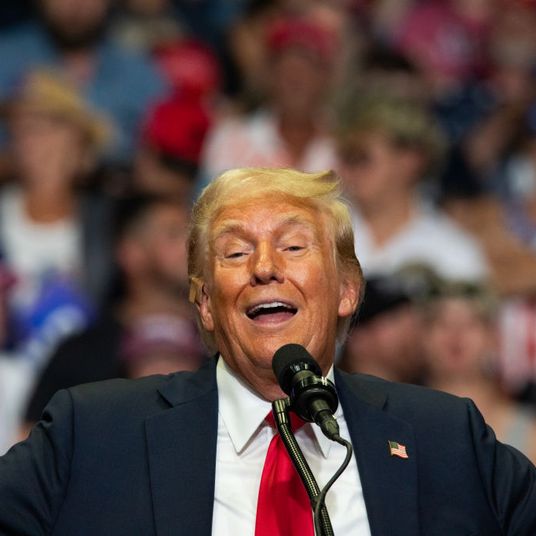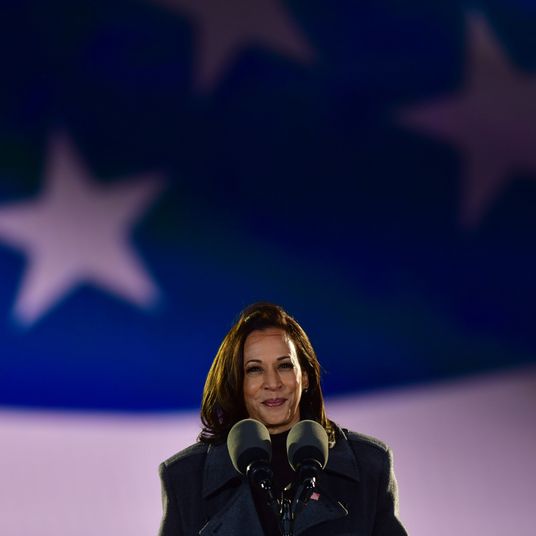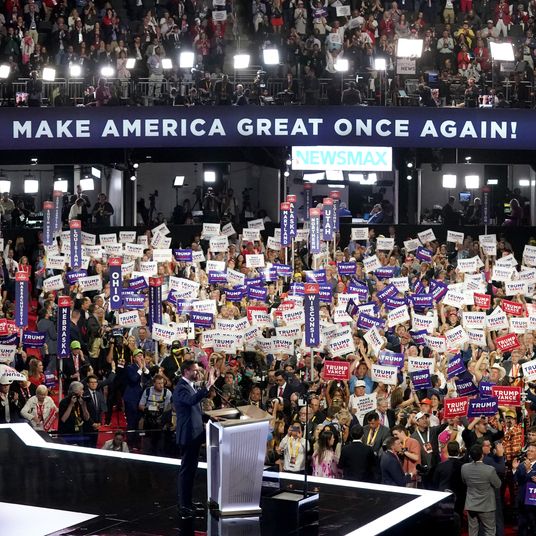
If there has been one appealing outcome of the chatter around Joe Biden’s dismal approval ratings and White House future, it’s the revelation that the Democratic bench isn’t so thin after all. Over the past seven years, the top Democratic contenders for the presidency have all been in their 60s and 70s, and now the younger generation, in this new decade, is asserting itself.
If they win reelection in the fall, Colorado governor Jared Polis and Michigan governor Gretchen Whitmer could make intriguing presidential candidates, having won twice in states where Republicans are competitive. Raphael Warnock, the senator from Georgia, is in a similar position, poised to become one of the few contenders who could re-create Barack Obama’s multiracial coalition if he survives a Republican challenge from the unhinged college-football legend Herschel Walker. In Pennsylvania, John Fetterman will be an instant national star if he beats Dr. Mehmet Oz in the Senate contest there. Beyond the swing-state Democrats, California governor Gavin Newsom and Illinois governor JB Pritzker have emerged as unapologetic battlers for the left-of-center Democratic agenda. Others are likely to emerge.
All of this is hypothetical, of course, because the 79-year-old Biden insists he is running again. If he does, no Democrat can defeat him. And if Biden bows out, the front-runner for the nomination will be Kamala Harris. Harris cannot clear the field like Biden can, but she will carry a decisive edge as the sitting vice-president. The trouble for liberals is that Harris is at least as unpopular as Biden, and her prior campaign for the presidency was a disaster. Against Donald Trump or Florida governor Ron DeSantis, neither Biden nor Harris inspire a great deal of confidence.
But all of this has obscured, for the most part, another dispiriting reality for the many progressives and leftists who have grown used to having one of their own run competitive races for the presidency: There is no obvious heir to Bernie Sanders. The Vermont senator, now 80, will almost certainly not run for president a third time. Sanders is an unabashedly left-wing democratic socialist who won major states in both of his presidential bids. If 2020 was a step back for Sanders — he won far fewer votes against Biden than he did against the polarizing Hillary Clinton four years earlier — he still broke through on major terrain, beating the field in enormous states like California and growing his support with working-class Latinos. He was wildly popular with voters under 30. Outside of perhaps Jesse Jackson or George McGovern, there was never a presidential candidate like Sanders in modern American history: someone who contested a Democratic primary from the far left, against the full brunt of the political Establishment, and finished runner-up each time.
Sanders had his weaknesses. He failed to win over a majority of Black voters, particularly those in the South, and struggled to compete with all voters over 50, who make up a large chunk of those who show up in primaries. His socialist brand limited him in states like Florida. His age, while a novelty in 2016, probably hampered him in 2020. A liberal coalition of Democratic voters, those deeply loyal to Clinton, always reviled Sanders, while his supporters who merely disliked her had evaporated four years later, choosing Biden instead.
Where does the left go from here exactly? The most obvious successors to Sanders are the Squad: the leftist members of Congress who endorsed him for president and, in the case of Alexandria Ocasio-Cortez, worked on his first presidential campaign. None, including AOC, are probably in a position to run in 2024 because members of the House have struggled, historically, to mount serious presidential bids. AOC herself will be turning just 35, the minimum age required by the Constitution to serve as president. Another congressman, Ro Khanna of California, co-chaired Sanders’s 2020 campaign and has been talked about as a future presidential candidate, but unless he reaches a higher office, he is unlikely to ever be a top-tier national candidate. Jamaal Bowman, a Squad member like AOC, could be a compelling contender one day if he ever rises to mayor, governor, or senator in New York.
There are no Squad senators or governors. There is Elizabeth Warren, who remains a Sanders ally to some degree and could run for president again. The Massachusetts senator, though, drew from a coalition that was more highly educated and left-liberal than Sanders’s assortment of young people, Latinos, and white working-class voters. She did not win a single state and ran third in Massachusetts, well behind Biden and Sanders.
The best immediate hope, in the absence of another Sanders, is that some future first-tier candidate decides to adopt pieces of his agenda, such as Fetterman, who has been a proponent of Medicare for All. Others may be sympathetic to canceling student debt, tuition-free public colleges and universities, and dramatically strengthening the social safety net. Even Biden has been more supportive of labor rights than any recent Democratic president, which represents a victory for the labor-first politics practiced by Sanders. The American withdrawal from Afghanistan, another long-sought Sanders goal, was finally achieved under Biden.
If the Squad represents the future of the left after Sanders, they would be wise to learn from his example. While Sanders represents one of the smallest states in America, he first rose to power at a time when Vermont was still voting for Republican presidential candidates. Sanders existed in a political world in which his leftism had to be made palatable to the kind of voter who could have preferred George H.W. Bush or Ronald Reagan. Representing a rural state that once swung between both parties, he developed an appreciation for talking to an ideologically heterodox constituency that wasn’t always going to support him on every issue. Sanders had to contort himself to appease gun owners and those who wanted a slice of the military-industrial complex at home.
The 2016 version of Sanders was probably his best: leading with economic concerns and speaking, whenever possible, in universal terms. The left’s future will be in building a multiracial, working-class coalition that began to take shape under Sanders but never grew big enough to overcome Clinton or Biden. Sanders won millions of fans talking about free health care and free higher education, wisely rebranding “single-payer health care” as Medicare for All, name-checking the popular program for senior citizens. He was more attentive to issues of race than his critics gave him credit for, though he was never going to win over moderate Black voters by featuring more incendiary activists and public speakers on his campaign, such as the scandal-scarred Shaun King. His failure to proudly identify as a Democrat — he has been an independent his whole life — probably helped do him in, along with his criticisms of the Obama-Biden wing of the party.
Squad members — particularly AOC, Rashida Tlaib, and Ilhan Omar — have leaned harder into the sort of polarizing cultural and policy issues that have diminishing national appeal. All embraced the defund-the-police movement, while Sanders, who has talked openly about boosting pay for young cops and had to manage a police department when he was Burlington’s mayor, avoided it as much as he could. Sanders, who is Jewish, does not back BDS, which has grown toxic with the average American Jewish or Christian voter who has warmer views toward Israel. He isn’t a backer of decriminalizing border crossings or radically liberalizing immigration policy. It could be argued, from the left, that Sanders is less enlightened for holding these positions, but they also place him much closer to the median American voter. The most progressive members of the House represent small, largely Democratic districts in which dialogue with moderates and conservatives isn’t necessary. For the left to really win — to go beyond Sanders, capture the Democratic nomination, and defeat a Republican — it will have to figure out how to successfully converse with the sort of voters who may alienate the average nonprofit activist in New York or Washington. The drift of working-class Latinos and Asians to the Republican Party makes this all the more challenging.
And the next Sanders, whenever she or he emerges, can learn from where the old campaigns couldn’t quite succeed. Though derided in progressive circles, the Democratic brand still matters. The Squad, wisely, all belong to the Democratic Party and are likely to remain that way. The independent label holds some appeal, but most voters want candidates who reliably exist in one party and identify that way. The word socialism itself is a double-edged sword; undoubtedly, the Cold War is long over and open socialists can succeed far more in American politics than they have in a century. Sanders wouldn’t have accrued such a devoted following if he hadn’t talked about democratic socialism. But for certain older voters and those who fled countries such as Cuba and Venezuela, the term is deeply toxic. Can a socialist be a socialist without using the word? It’s a vexing question for some on the left with no easy answer. Certainly, shrouding more far-reaching and left-wing policies in a veil of moderation is wise — it’s why Sanders effectively invented Medicare for All. In the meantime, the forces that rallied for Sanders can try to seek influence in the next open presidential primary, seeding their ideas in as many campaigns as possible. One man from Vermont needn’t be the vehicle for all sweeping change in America.


























